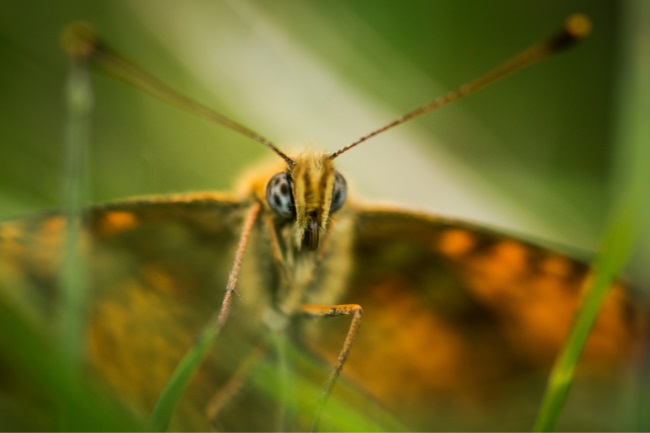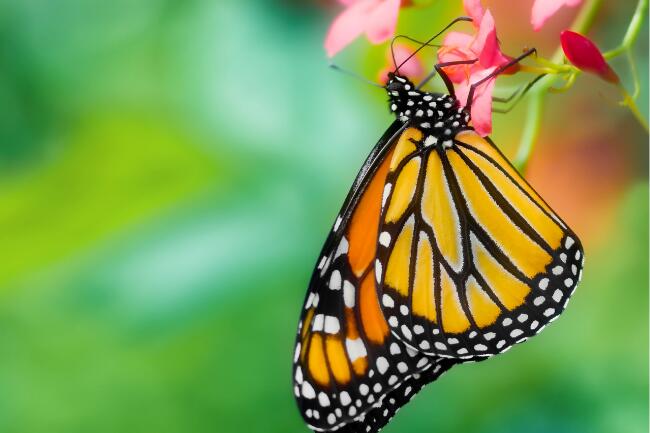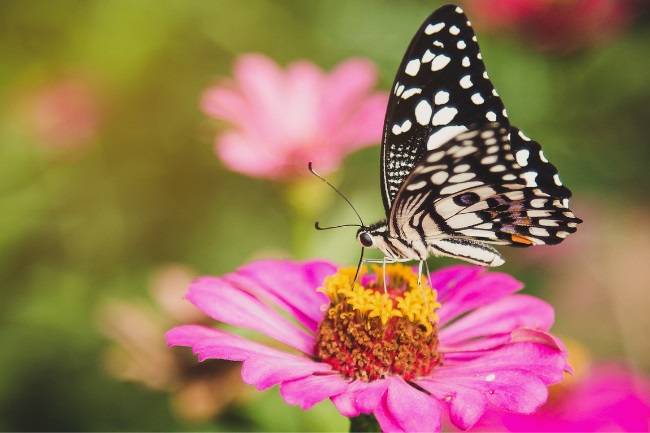Butterflies have six legs, in two pairs of three arranged on either side of their thorax. While they use their wings to get about, their legs are important for standing on vegetation to feed, mate and lay eggs.
Contents
Do butterflies have legs?

For most people, if they sit down to draw a butterfly, they will concentrate on the wings. The wings of a butterfly are after all much bigger and more colourful than the rest of them. This will then be followed by a small body, and perhaps a set of antennas. Often no legs at all will be added to the drawing.
Yet all butterflies possess legs. Due to their slender size, and the fact that they are often tucked under the butterfly’s body, we often don’t notice them. It may not seem important to have legs when wings are the main form of transportation, but they are a vital part of the butterfly’s ability to feed and reproduce.
Also read: Do Butterflies Mate for Life? Eternal Love or…
How many legs does a butterfly have?

For many of the world’s animals, from birds to mammals, even to us, there is surprisingly little variability in how many legs a creature has. In the vast majority four has become the ideal number of legs to get something from a to b. In a few this number has been halved, allowing the other set to become arms, or in the case of birds and bats, wings.
Yet, when it comes to the world of creepy crawlies, there is an amazing array of legs to be had. From the eight legs of a spider to the almost countless legs of a millipede, to everything in between.
It may seem rather chaotic at first, however, there is some order to all these many pairs of scuttling feet. The most memorable rule that many of us have been taught is that spiders will always have eight legs. A similar rule applies to insects, who will always have six legs. This may at first seem confusing as many people mistakenly think that spiders are themselves insects, however, they are in fact a part of a separate group.
Butterflies are, however, a type of insect, and the rule of six holds true even for them. As with all insects, the six legs are arranged in two sets of three, either side of the butterflies body. They are attached to the thorax, which is the second of three segments that make up an insect’s body; the head, the thorax and the abdomen.
The legs are made up of six interconnected sections, each of which can move at the joints. At the end of the legs are hooks, which allow them to attach themselves to surfaces without using much energy. This is handy for when they are resting or in diapause over winter.
Also read: Do Butterflies have Eyes? What do They See?
The Four-legged butterflies

While all butterflies do have six legs there’s a group of butterflies who only use two sets of their legs to go about their day-to-day business. The front two legs are smaller and kept tucked away. This group is called the Nymphalidae, and is one of the biggest groups of butterflies, containing 6,000 species.
These butterflies are also known as the brush-foot butterflies because in many species the two smaller legs can be brush-like. Painted ladies are one of the brush-foot butterflies.
The reason for these butterflies having two smaller legs is currently unclear but may be beneficial for the butterflies to use them for signalling. They have also been know to use these fluffy feet for grooming.
Also read: Can a Butterfly’s Wings Grow Back? (Explained)
Why do butterflies need legs?
We might feel like there’s no need for legs when you have a set of wings, but butterflies still need they important limbs for all sorts of reasons. Butterflies often perch on vegetation in order to feed on flowers or to rest.
Additionally, not all butterflies are great fliers, the mountain ringlet is one species that doesn’t take to the wing often, preferring to walk when possible.
Another handy and surprising task that butterfly legs are useful for is tasting, as butterflies are able to taste what they are standing on, therefore being able to decide if it’s suitable to eat, and even using this skill to select the right flowers to lay their eggs on.
The disappearing legs
As well as those species who have developed a set of smaller legs butterflies have a history of getting a little legless. Their caterpillars start life with many more legs than the adults they become, but these are largely unjointed legs rather true legs. Throughout their lives, butterflies will always have three sets of jointed legs.
A butterflies wings may be the first thing we notice, but without their handy legs to cling onto the vegetation while their new wings unfurl these insects would never get off the ground. Whether they make use of all three sets or just two they certainly couldn’t do without them.

